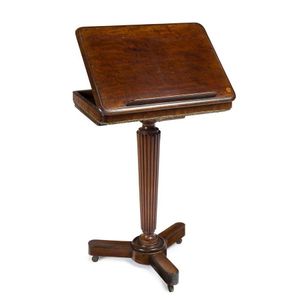Ebonised Card Table with Maple Inlay and Birdcage Base
A late 19th century ebonised card table with maple inlaid panels to top and legs, ornate birdcage base. Height 73 cm. Width 90 cm. Depth 44 cm
You must be a subscriber, and be logged in to view price and dealer details.
Subscribe Now to view actual auction price for this item
When you subscribe, you have the option of setting the currency in which to display prices to $Au, $US, $NZ or Stg.
This item has been sold, and the description, image and price are for reference purposes only.
- Ebonised - Timber that has been stained or lacquered black in imitation of ebony. The process has been used since the Renaissance, but is most commonly found in late 19th century furniture, sometimes gilded and turned in imitation of bamboo. Furniture with an ebonised finish is not currently in vogue, and this is reflected in the price for such pieces.
- Panels - Timber pieces, usually of well-figured wood either recessed or applied over the frames of doors and as decoration elsewhere in the carcase of cabinet furniture. The panels may take a variety of shapes rectangular, square, shield shape, oval, half-round or in the form of Egyptian pylons.
- Maple - Maple, native to North America, is a dense heavy timber from light to yellow-brown in colour. It has very little distincive graining unless it is one of the variants such as birds-eye maple or burr maple, so was not used extensively for furniture in 18th and 19th century, where cabinetmakers and designers preferred timbers with more distinctive features such as mahogany, walnut, rosewood and oak.
Birds-eye maple has a seres of small spots linked by undulating lines in the grain, is highly sough and is used as a decorative veneer. Burr maple has larger and irregular grain swirls than birds-eye maple. - Inlay - Decorative patterns inserted into the main body of a piece of furniture, generally in wood of contrasting colour and grain, though brass, ivory, ebony, shell and sometimes horn have been used. Inlay may consist of a panel of well figured timber inset into a cabinet door front, geometric patterns, or complex and stylized designs of flowers, swags of foliage, fruits and other motifs. As a general rule, in pieces where the carcase is constructed in the solid, the inlay is relatively simple such as stringing, cross banding and herringbone banding. Where more elaborate and decorative work was required veneer was used. Inlay has been fashionable from at least the latter half of the 17th century, when a variety of elaborate forms were developed
This item has been included into following indexes:
Visually similar items

Ladies work table, mahogany Sheraton style with pedestal base and mirror back interior barley turned column, height 77 cm
Sold by
in
for
You can display prices in $Au, $US, $NZ or Stg.

A mahogany tea table, English mid 19th century, 76 cm high, 100 cm wide and 50 cm deep
Sold by
in
for
You can display prices in $Au, $US, $NZ or Stg.

A William IV mahogany music stand table, 76 cm high, 56 cm wide, 42 cm deep
Sold by
in
for
You can display prices in $Au, $US, $NZ or Stg.

A Regency mahogany fold over card table, 74 cm high, 92 cm wide, 46 cm deep
Sold by
in
for
You can display prices in $Au, $US, $NZ or Stg.
